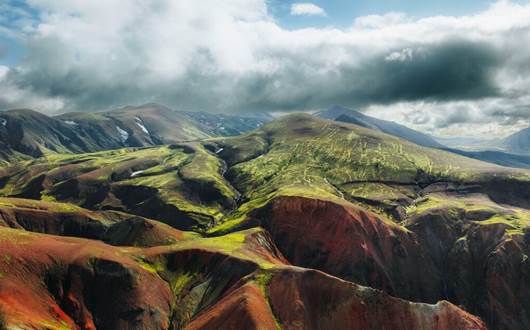
Hiking in Iceland: Guide to the Best Iceland Hikes, Trails, and Seasons
Experience nature at its rawest as the Iceland hiking trails take you across rugged peaks, icy plateaus, and ancient lava flows.
Iceland’s epic sights come with epic weather—smart clothing choices will make all the difference. You only need to learn a few basics!
The weather patterns in Iceland are famously unpredictable— it's calm and sunny one moment, a full-on storm the next. A famous saying, "There is no such thing as bad weather, just bad clothing." is especially true here. Knowing what to wear in Iceland is so important because, without the right gear, you risk feeling cold, wet, and miserable. Wind, rain, and temperature changes are all part of the experience, but dressing smartly will keep you warm, dry, and ready for your explorations.
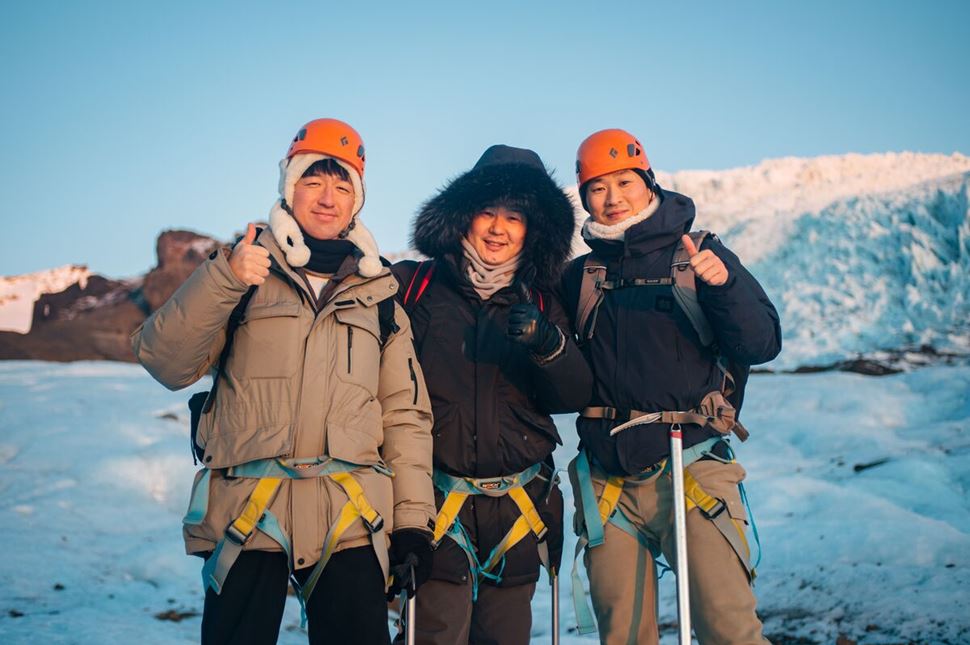
Insulated and waterproof winter attire is essential in Iceland.
Many people think Iceland is always cold—it makes sense with a name like that. But Icelandic weather is far from straightforward. Sun, rain, wind, and even hail can happen all in one day, so learning what to pack for Iceland is key. With only two main seasons, summer and winter, fall and spring are brief transitions that don’t feel like seasons at all.
Knowing how to dress for these two extremes is enough. And don’t forget activities—watching the Northern Lights in light hiking clothes or climbing a mountain in wool sweaters won’t work. Each season’s adventure calls for its own Icelandic packing list and approach to staying comfortable and prepared.
Although not unbearable, winter in Iceland is quite cold, with daylight time being only three to four hours. Average temperatures hover around -2°C (28.4°F), though strong winds can make it feel like -15°C (5°F). These conditions last from October to early April, so proper winter Iceland outfits are essential for longer than three months a year.
To keep warm, you will need to learn how to layer up:
Comfortable, waterproof hiking boots and ski or soft-shell pants or salopettes are essential, as are warm fleece socks, gloves, a scarf, and a hat to protect your extremities. For icy terrain, lightweight crampons are a must. They provide traction on slippery paths and are easy to use—perfect for exploring frozen trails. If you’re traveling with us, you can add crampons while booking for a safe winter adventure. With the right attire for Iceland in winter, you’ll stay warm and ready to explore.
Insider's advice: Don't forget to pack lip balm and thick face moisturizer. Windy conditions can be harsh on your skin.
What to wear when snowmobiling: To ride a snowmobile, wear a special snowmobiling suit, wool-lined boots, non-cotton socks, and protective gear such as a helmet, goggles, and balaclava.
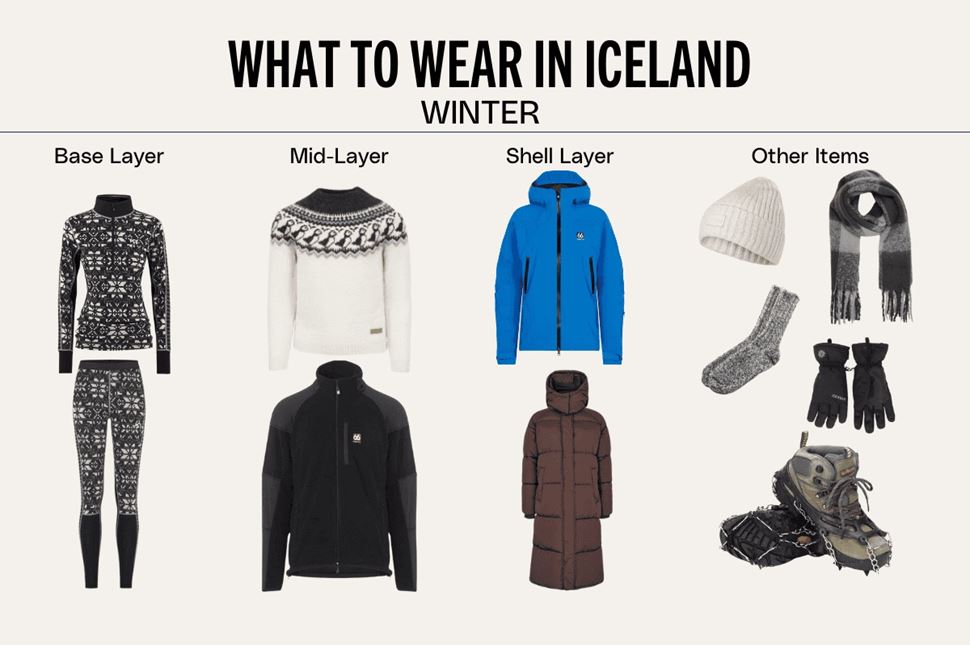
Must-have clothing for the colder months in Iceland. Source: Arctic Adventures.
» In October - With temperatures around 5.5°C (42°F) and frequent rain, focus on staying dry. In addition to your three layers, bring fully waterproof outerwear, sturdy hiking boots, and a beanie. Pack extra clothes in case you get drenched.
» In November - It’s around 2°C (36°F) in the daytime, but strong winds are common, so layer up with windproof outerwear. Add a wool scarf, insulated gloves, and a hat that covers your ears to stay warm in blustery conditions.
» In December - Focus on insulated gear, as temperatures average -1°C (30°F). In addition to your base layers, pack snow pants, wool-lined socks, and a puffer jacket or parka to retain warmth during the long, cold nights.
» In January - The coldest month, with temperatures ranging from -3°C to 3°C (26°F to 37°F), requires serious warmth. Add fleece-lined leggings, thick gloves, and a neck gaiter to your other layers to handle icy winds.
» In February - Known for its unpredictable weather, temperatures vary between -1 and 1°C (30 to 34°F) on the same day. In addition to your base layers, bring waterproof gloves, a balaclava for wind protection, and quick-drying outerwear for sleety weather.
» In March - As the thaw begins, temperatures hover around 0°C (32°F), with lots of rain or sleet, so prioritize water resistance. In addition to your regular layers, pack a softshell jacket, water-resistant pants, and thick hiking socks to stay dry and warm.
» In April - During this transitional month, temperatures average 3°C (37°F), but it can feel colder in windy areas. In addition to your three layers, pack lightweight yet warm accessories like windproof gloves, a hat, and a scarf to handle unpredictable weather.
Glacier hiking in Iceland is a bucket-list adventure, and with ice covering so much of the country, it’s a must-do any time of year. In winter, wear thermal vests, fleece sweaters, insulated jackets, and warm leggings under trousers or salopettes to stay warm. In summer, carry layers—you can remove a fleece if it’s sunny, but keep extras for sudden weather changes.
Avoid denim, as it stays wet and restricts movement. Sunglasses or ski goggles are essential year-round to shield against the sun reflecting off the ice. Always wear non-slip, waterproof boots paired with crampons or other traction devices for grip on the ice. Accessories like waterproof gloves, a beanie, and a neck cover are must-haves to protect against the winds. When exploring glaciers in Iceland, your guide will also supply the specialized glacier gear—helmets, harnesses, and crampons.
The summer season in Iceland is a masterpiece of nature, with its green, orange, red, black, and blue landscapes creating a painting-like atmosphere. It’s the perfect time for hiking and trekking in Iceland's highlights, horseback riding along the Golden Circle, whale watching from Reykjavik harbor, or soaking in geothermal baths. For all these adventures, your summer Iceland outfits need to be versatile and lightweight.
Daytime temperatures hover around 15°C (59°F), dropping to around 7°C (45°F) at night. Therefore, dressing like an onion—light clothes underneath and layers on top—is the smartest choice. Since the wind is this island’s best friend, a windproof jacket always saves the day. If it’s not waterproof, you can pair it with a disposable rain poncho.
Skip umbrellas—they’re useless against the wind. The weight of your mid-layer affects your mobility, so go for lightweight fleece or skip it entirely, relying on a base layer and a shell. It would be even better to bring some water-resistant outdoor pants.
Pack T-shirts and shorts for warm days, but avoid denim and cotton, which don’t dry quickly. A Merino wool T-shirt works wonders. Bring swimsuits—not for beaches, but for pools, lagoons, and hot springs. Add sunglasses, a cap for sunny days, and warm socks and gloves for chilly evenings, ensuring you’re ready for Iceland’s unique summer conditions.
Insider's advice: Tie back long hair—it’s no match for Iceland’s winds and can quickly ruin a photo moment near majestic waterfalls like Gullfoss or other memorable stops.
What to wear to Blue Lagoon: To relax in the Blue Lagoon Spa, wear a bathing suit, flip-flops, or water shoes for walking outside the pool. A towel and bathrobe can be rented.
What to wear when rafting in summer: For river rafting in Iceland, wear a non-cotton swimsuit or shorts without loose edges, with a wetsuit or drysuit, life jacket, helmet, and water shoes provided on-site.
What to wear when snorkeling: When snorkeling in Iceland, wear a thin thermal base layer—wool or synthetic tops, pants, and socks—plus neoprene gloves, hood, and drysuit for warmth.
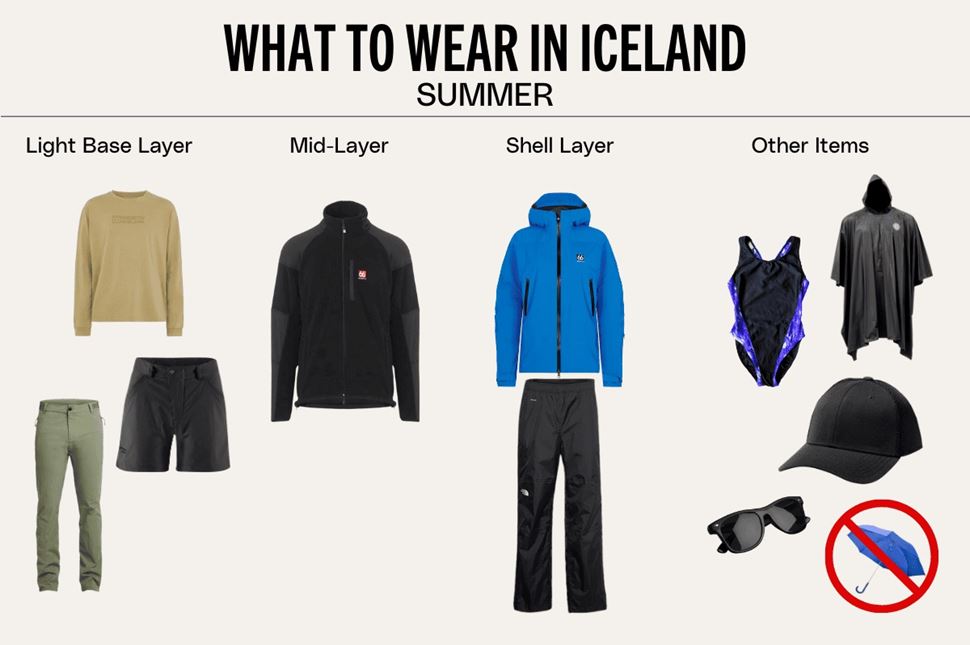
Clothing for warmer months in Iceland. Source: Arctic Adventures.
» In May - With temperatures around 3–9°C (37–48°F), days vary from sunny to windy and chilly. Wear T-shirts, shorts, a fleece, waterproof pants, and a windproof jacket. Wool socks and hiking boots are essential for comfort.
» In June - Averaging 9.2°C (48.5°F), the weather shifts between warm and rainy. Wear a fleece, lightweight pants, a waterproof jacket, gloves, and hiking boots. Pack a bathing suit for geothermal pools.
» In July - At 9–13°C (48–55°F), t-shirts and shorts work for warmer days, but thermal layers and a waterproof jacket or rain poncho keep you ready for sudden rain. Warm socks and gloves are helpful for cooler evenings.
» In August - During the last month of summer, temperatures drop to around 10.3°C (50.5°F). Wear base layers, a sweater, waterproof pants, and hiking boots. Add gloves, wool socks, and a waterproof jacket to stay warm and dry in the rain.
» In September - As the weather starts to cool down to 5–10°C (41–50°F), layering is more important than ever. Wool base layers, a sweater, waterproof outerwear, gloves, and a windproof jacket will keep you cozy during this transitional month.
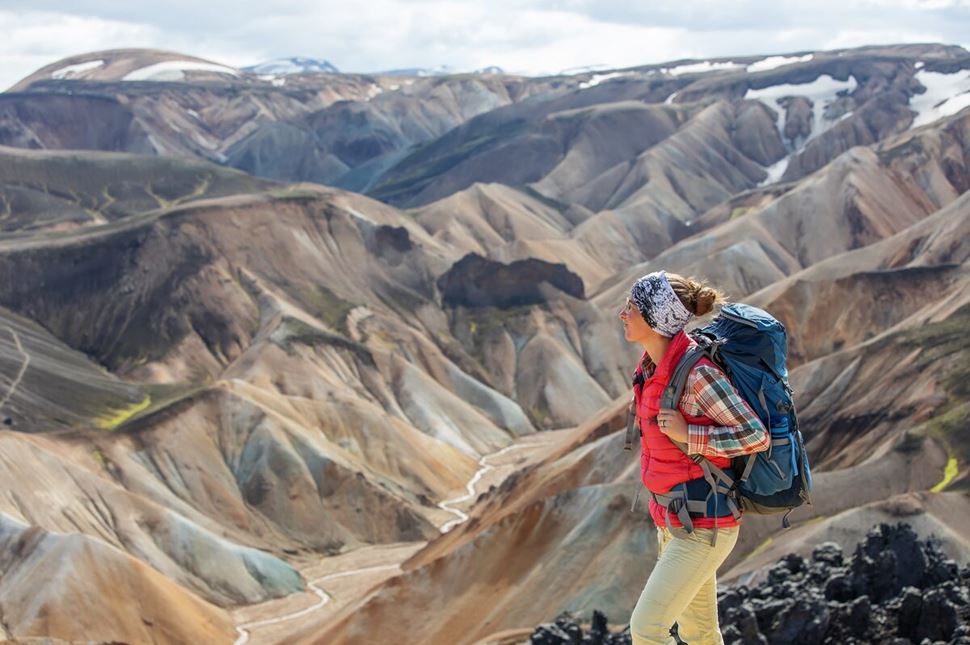
Dress appropriately for summer hiking in the Icelandic Highlands.
Hiking in Iceland is popular during the warm season, but sudden weather changes and strong winds can catch you off guard. To stay comfortable, you must prepare for your hike.
Strategically layer your clothing to balance insulation and ventilation:
When deciding what socks to wear with hiking boots in summer, opt for merino wool for its moisture-wicking properties, which will help prevent blisters and keep your feet warm. Finally, sturdy hiking boots go without saying, but you can add microspikes for slippery trails. These essentials will make hiking Iceland's rugged trails a lot more fun.
The main thing to consider when choosing shoes for Iceland is that they must be proper hiking boots with waterproofing and ankle support — regardless of the season. Look for high-quality options with Gore-Tex or similar technology to keep your feet dry and warm.
Keep in mind that the best hiking boots for Iceland should be comfortable for long wear and durable for rocky terrain. Break them in before the trip to avoid discomfort or blisters. In winter, skip snow boots because, while very warm, they often lack the necessary support and traction. For casual use or summer trips, you can wear sneakers for city exploring and flip-flops or pool shoes for hot tubs and showers.
It may not be obvious, but many of your favorite vacation outfits will need to stay at home when heading to Iceland. Beyond the city, practicality is key. For sightseeing in Iceland’s rugged outdoors, there are some things to absolutely avoid:
Just like all Scandinavian fashion, Iceland's clothing style is very much dependent on the weather. You’ll see people wearing smart clothing: tailored, sustainable, and functional. Icelanders tend to have fewer items in their wardrobes, but they are all good quality.
In everyday Iceland fashion, you might see jeans (strictly as city wear only), leggings, and yoga pants paired with warm sweaters or long-sleeve tops. Iceland outfits tend to vary from dark to neutral tones, with one or two pops of color. Brands like 66°North and Icewear are popular for their classic Nordic aesthetic and practicality.
If you struggle to decide what to wear to dinner in Iceland, don’t overthink it. There isn’t really a dress code unless you are going to a special event like a wedding or graduation. For dining at a restaurant, indoor pants, a simple t-shirt or sweater, and non-hiking shoes are perfectly appropriate.
The same rules apply to Iceland's nightlife dress code - most people dress smart casual. You’ll notice that even the best restaurants in Reykjavik accept casual attire. Of course, it doesn’t mean that Icelanders don’t care about fashion. There are countless clothing shops that sell great outfits for sightseeing and for going out!
The capital, Reykjavik, is probably the best place for clothes shopping in Iceland. Locals like big indoor malls, so most clothing shops in Iceland are all in one place. One of the most popular malls is Kringlan - the country’s second-largest shopping center, which hosts over 170 shops.
The most popular Iceland clothing brand is 66° North, together with Icewear. They specialize in outdoor clothing and have several stores in Reykjavik, Akureyri, and other towns. Their clothes are highly durable, functional, and, most importantly, warm, drawing inspiration from traditional Icelandic garments.

Traditional Icelandic sweater Lopapeysa.
Icelandic clothing has always revolved around wool, knitwear, and patterns inspired by nature, reflecting the country’s culture and climate. The iconic Lopapeysa sweater, made from local sheep wool, is warm, water-resistant, and features circular yoke designs.
Icelanders’ traditional national costumes were practical and sustainable, closely tied to nature. Men wore a woolen form of waistcoat called Brjóstadúkur, knee-length breeches, and waistcoats. Women dressed in long Kyrtill gowns with blouses, brooches, and belts. Both genders covered their heads with caps like the tall, curved Faldur. So, if you’re unsure how to dress for this climate, take inspiration from the traditional costumes of Iceland and the locals’ timeless love for wool and hats!
Always dress in layers. Wear quickly-drying materials like synthetics and wool. Iceland is a windy country with frequent rainfall. A quick-dry shirt and leggings, warm fleece, and a waterproof shell jacket will keep you cozy and dry.
Yes and no. You can wear jeans in Iceland, but they’re best reserved for cities or casual outings. For outdoor activities or sightseeing, jeans aren’t ideal as they absorb moisture, dry slowly, and can restrict movement. Opt for quick-drying, comfortable pants for nature-based adventures.
Yes and no, sneakers work well for long drives and walking around town on a dry day, especially in summer. However, they aren’t ideal for Iceland’s outdoor trips, where hiking boots are better for waterproofing, warmth, and year-round use. Winter’s harsh conditions make sturdy hiking shoes essential.
Yes, hiking boots are highly recommended for Iceland in all seasons and for most activities. Waterproof boots with good ankle support are essential for uneven terrain, wet conditions, and rocky paths. Even for shorter hikes, the comfort and durability of hiking boots make a huge difference in Iceland’s unpredictable weather.
When going on a Northern Lights hunt in Iceland, you must dress in your warmest clothes. This exciting activity requires lots of standing in one place at night during the winter season. Wear wool thermals, a wool sweater or fleece, snow pants, and a highly insulated waterproof jacket. Wool socks and snow boots will keep your feet warm, and don’t forget a hat and gloves for extra protection.
Icelanders like to dress in layers. For a base layer, they usually wear thermals with a wool sweater or a fleece jacket on top. The outer layer is usually an insulated waterproof puffer jacket or parka. As for shoes, they usually wear insulated waterproof boots or hiking boots with crampons or steel spikes.
You can choose from various options, such as ski jackets, puffer jackets, or parkas, preferably knee-length. Puffer jackets and parkas are a bit warmer but less breathable. Ski jackets offer more breathability but are often heavier and more difficult to pack.
The shoes for Icelandic winter have to be well-insulated and waterproof. Hiking boots most often meet those requirements perfectly. However, if you want something extra warm, you can also wear snow boots with fleece inside, although they may not be as sturdy.
Icelanders dress very practically but with a modern Scandinavian touch. You will often see technical clothing: warm sweaters, waterproof coats, and solid shoes—always ready for infamous weather. For going out, it’s common to dress in a smart casual style.
Iceland’s traditional clothing is called “Þjóðbúningurinn.” It includes outfits like the “upphlutur,” a fitted bodice with a skirt, and the “peysuföt,” which features a wool blouse and skirt. These outfits were often decorated with embroidery inspired by Icelandic nature. Very practical but also beautiful!
Iceland is home to the world’s most active volcanos, Europe’s largest glaciers, and some of the most famous hot springs. It is also characterized by otherworldly landscapes, numerous waterfalls, and black sand beaches. Iceland's beauty is simply raw and untouched.
Icelanders are very friendly, many speak English, and they always welcome tourists. You will notice that locals are straightforward and kind, with a strong sense of fairness. However, they don’t accept travelers who break Icelandic laws or disrespect nature.
When exploring Iceland's scenic routes, such as the Golden Circle, Silver Circle, or Ring Road, dress in layers to stay comfortable in changing weather. Even on a road trip, you may face rain, wind, or snow, especially in winter. A waterproof jacket, sturdy footwear, and insulated layers will keep you warm and dry during stops at outdoor attractions like waterfalls, hot springs, and glaciers.
Best Seller